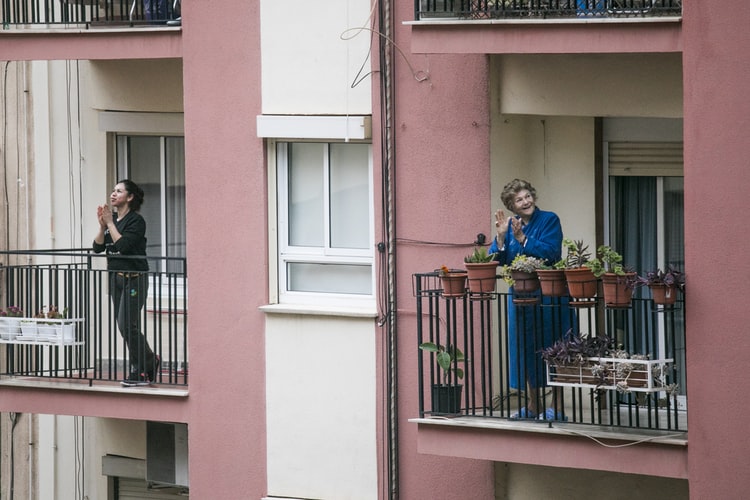Looking Inside From The Balcony: How Convenient Our Houses Are To Live In?

Apart from the balcony culture, when we consider the issue in terms of spatial rights during the epidemic, the balcony appears as a small but symbolic indicator of inequalities. The balconies that are part of the right to housing need to be handled more comprehensively.
I am writing these lines from my balcony where the sun strokes my face delightfully, being thankful that I am able to stay at home and have access to a balcony, though small. Exploring the mischievous crows that visit my balcony is one of the things that brighten my day. Have they pecked my dry peppers, how quickly did they eat up the breadcrumbs? I could not imagine that this little balcony could give me such a feeling of freedom or could be a breath to me. I am once again glad that we had bought the blue table and chairs that we bought last summer. I’m trying to see the lake among the asphalt jungle. It is the first time that the eerieness of living on the thirteenth floor turns itself into something beautiful: a balcony with an open front and a view, and into a luxury in such a period.
A house is a place where we live in, where we feel safe, and even where we define ourselves with from time to time. As the functions attributed to this space became more important with the Covid effect, the meanings attributed to it began to change. The house suddenly became a school, a workplace. With the uncertainty, the future anxiety, the combination of all these functions and the danger of going out, we have become unable to breathe. Especially, balconies have become a new expression of freedom (özgürlüğün yeni bir ifadesi) for those living in apartment buildings among the chaos of the city life as they allow accessing open air without violating social isolation and without the danger of the virus. In countries such as Italy, where the number of cases and deaths increased, balconies have become the symbols of hope (umudun simgesi ). We witnessed many colorful events from all over the world, from balcony concerts to the fitness instructor (fitness hocasına) who provide free training to their neighbors in Germany, to runner (koşucuya,) who completed a marathon on his balcony in France, and cheers for support of healthcare workers. We celebrated national holidays such as April 23 or May 1 from our balconies and windows.
Beyond The Balcony Culture: Perceiving From The Angle Of Spatial Rights
During this period, we have looked at our balconies which are sometimes been turned into semi-warehouses, covered with glasses or remained completely idle in many houses. Its meaning has changed for those who have used them before, but a brand new hobby has emerged for those who do not use theirs. Balconies start to be discussed (tartışmalara) among many different media channels. Although some experts claim that balconies do not have a function rather than being included into the area of the house and being used as a warehouse or not usually used due to privacy reasons, it would be more general to say that Turkey in which every region differs with their own structure, does not have a balcony culture. Although the effects of the balconies have weakened in large cities over time, Turkey has always had a strong balcony culture especially in regions with warmer climate. Even in the most conservative sections where the emphasis of privacy is high, we all witnessed the balconies used by pulling the curtains over them.
Apart from the balcony culture, when we consider the issue in terms of spatial rights during the epidemic, the balcony appears as a small but symbolic indicator of inequalities. The balconies that are part of the right to housing need to be handled more comprehensively.
When we look at the issue from the perspective of spatial justice, we are in times when we need to re-discuss and think about the right to housing, because in this period, we witness that existing inequalities have deepened and have manifested themselves more. As stated in the latest guides published by UN Housing Rights Special Interviewer Leilani Farha: “The house has become a front defense against the coronavirus. It is rarely seen that the house is such a matter of life and death. ”
Urban Planner and Urban Historian Gizem Kıygı defines balconies as more comprehensive spatial patterns than a discussion area in which the right to housing consists of four walls, and as a part of a discussion area where the ties of human psychology are clearly put forward. Of course, the most vulnerable groups that need to get the most urgent solutions for the current crisis are certain: homeless people and refugees. However, housing is the right of everyone and when we say the right to housing, we are talking about the right to live in a healthy and safe housing.
“Housing is a Symbol of Social Injustice”
The elements of housing defined by the United Nations as the right to livable housing (yaşamaya elverişli konut hakkı) which provides living conditions that are compatible with human dignity are as follows: living within the house without worrying about displacement, having access to urban services such as water, sewage, heating and electricity, the house being affordable without being overbudget, meeting the different needs of different groups, providing a healthy and sufficient living space with its architectural design, being easily and comfortably accessible and being suitable for the cultural identity and lifestyle of the surrounding environment.
A City Planner from the Center For Spatial Justice Bahar Bayhan has summarized this discussion that emerged with the Covid outbreak multidimensionally pretty well: “We are at a time when everyone questions the places that we call “home”. Beyond being a place visited among the work and home cycle, we attach new meanings to it in line with our needs. Yes, there was a need for areas that provide access to the open air at home, such as a balcony, but we need to question who has access to spacious houses with that balcony. Which of us are really safe, healthy, and how many of us live in homes that we can pay without limiting our needs or wishes? Today, housing stands out as a symbol of social injustice. This is an injustice that extends from the middle-upper class who renew their houses with urban transformation into small residence apartments without balconies, to the refugees living with their crowded families in a single-room without a balcony. We have to rethink housing as a human right and demand the right to housing.”
We need to see how important the “home” concept corresponds to within our lives by evaluating the issue over the earthquake threat we are living under, over our ever-decreasing green spaces or over the new types of houses imposed by urban transformations, and we need to realize our own needs and priorities and make demands for this.
We need to talk about what is needed to be discussed currently, so that we can prepare ourselves for later and take the necessary measures so that the existing inequalities do not deepen further. Because spatial inequality is particularly fragile, especially with the earthquake and other risk factors in Istanbul.
“What Kind Of A House?”
Stating that the minimum conditions that a healthy and safe housing must have such as accessibility to green areas, catching sun, having a balcony, not being humid, being close to the market, grocery store etc. are almost only valid among luxury housings, Gizem Kıygı foresees that the housing mobility that may occur in the post-pandemic process will be accordingly discriminative: “Covid has hit us hard, and we’re going through many orientations and changes right now. The process we are in is a crisis close to disaster, and there are even those who call it disaster. After such crises, usually a large housing mobility occurs, especially in big cities. Therefore, the demands such as balconies or the apartment or house to be located close to green areas will cause a certain housing mobility. My prediction is in this direction. This housing mobility still seems to correspond to a class mobility.” Another aspect that Kıygı draws attention to is that this potential class mobility has the risk that some of the houses, which are already difficult to access, can turn into something completely inaccessible for disadvantaged groups. In short, as can be expected, our current situation carries the risk of deepening the existing inequalities even more.
Bayhan, who questioned the social and environmental justice that had existed before the epidemic and who drew attention to the solidarity practices that played an active role in this process, underlined the importance of a rights-based approach: “I think that collectives’ memory of experience will contribute to the upcoming process. The epidemic has exposed the dilemmas of city life and we’ve witnessed the negative impact of intense urbanization on public health. First of all, local governments should learn lessons. They should evaluate the aggrievements experienced during the epidemic and should look at the issue from the perspective of accessing to rights, not from an aid-based approach. In this process, the existence of civil society which will demand the rights and emphasize injustice gains importance.”
Considering access to healthy and safe housing as a human right will be useful both to understand inequalities and to gain a basic perspective that will lead us to a solution. As civil society, we must evaluate the issue, monitor it and create the necessary pressure. Of course, in the fight against Covid, #stayathome slogan is one of the most basic strategies, but we also need to ask ourselves and each other and policy makers: which house for who? What kind of a house?

Bizi Takip Edin